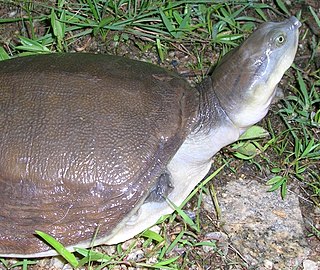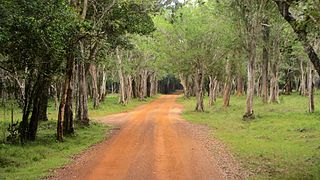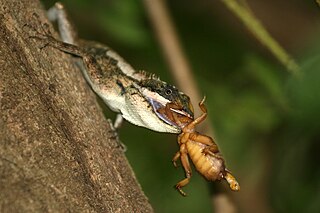
The Sri Lanka white-eye is a small passerine bird in the white-eye family, which is endemic to Sri Lanka. It is a resident breeder in forests, gardens and plantations, mainly in the highlands.

The grey-headed canary-flycatcher, sometimes known as the grey-headed flycatcher, is a species of small flycatcher-like bird found in tropical Asia. It has a square crest, a grey hood and yellow underparts. They are found mainly in forested habitats where they often join other birds in mixed-species foraging flocks. Pairs are often seen as they forage for insects by making flycatcher-like sallies and calling aloud. Several subspecies are recognized within their wide distribution range. In the past the genus Culicicapa was considered to be an Old World flycatcher but studies have found them to belong to a new family designated as the Stenostiridae or fairy flycatchers that include the African genera Stenostira and Elminia.

Boiga ceylonensis is a species of rear-fanged, mildly venomous, nocturnal, arboreal colubrid snake endemic to Sri Lanka.

The Indian flapshell turtle is a freshwater species of turtle found in South Asia. The "flap-shelled" name stems from the presence of femoral flaps located on the plastron. These flaps of skin cover the limbs when they retract into the shell. It is unclear what protection the flaps offer against predators. Indian flapshell turtles are widespread and common in the South Asian provinces. It is morphologically an evolutionary link between the softshell and hardshell aquatic turtles. Exploitation for profit and habitat change are threats to their survival.

Lissemys is a genus of softshell turtles in the subfamily Cyclanorbinae of the family Trionychidae. The genus is indigenous to southern Asia.

The Burmese flapshell turtle, is a species in the family Trionychidae. The species is endemic to Asia.

Nannophrys ceylonensis, commonly known as the Sri Lanka rock frog or the Ceylon streamlined frog, is a species of frog. It used to be placed in the large frog family Ranidae but a phylogenetic study was undertaken using DNA sequences and it is now included in the family Dicroglossidae. It is endemic to Sri Lanka where its natural habitats are subtropical or tropical moist lowland forests, subtropical or tropical moist montane forests, rivers and streams.

Wilpattu National Park is a national park in Sri Lanka. The unique feature of this park is the existence of "Willus" – natural, sand-rimmed water basins or depressions that fill with rainwater. Located on the northwest coast lowland dry zone of Sri Lanka, the park is 30 km (19 mi) west of Anuradhapura and 26 km (16 mi) north of Puttalam. The park is 1,317 km2 (508 sq mi) in area and ranges from 0–152 m (0–499 ft) above sea level. Nearly one hundred and six lakes (Willu) and tanks are found spread throughout Wilpattu. Wilpattu is the largest and one of the oldest national parks in Sri Lanka. Wilpattu is world-renowned for its leopard population. A remote camera survey conducted in Wilpattu from July to October 2015 by the Wilderness and Wildlife Conservation Trust captured photographs of forty-nine individual leopards in the surveyed area, the core area density of which was between that of Yala National Park's Block I and Horton Plains National Park.
Lahugala Kitulana National Park is one of the smallest national parks in Sri Lanka. Despite its land area, the park is an important habitat for Sri Lankan elephant and endemic birds of Sri Lanka. The national park contains the reservoirs of Lahugala, Kitulana and Sengamuwa and they are ultimately empties to Heda Oya river. Originally it was designated as a wildlife sanctuary on July 1 of 1966. Then the protected area was upgraded to a national park on October 31 of 1980. Lahugala Kitulana is situated 318 km east of Colombo.

Garra ceylonensis is a species of ray-finned fish in the cyprinid family. It is endemic to rivers and streams in Sri Lanka - and is considered as a schooling fish. It is a rheophilic species and occurs in slow to moderately flowing rivers and streams, and ascends small, rocky streams in order to breed. It primarily feeds on algae such as diatoms.
Flood Plains National Park is one of the four national parks set aside under the Mahaweli River development project in Sri Lanka. The park was created on 7 August 1984. The national park is situated along the Mahaweli flood plain and is considered a rich feeding ground for elephants. Flood Plains National Park is considered an elephant corridor for the elephants migrate between Wasgamuwa and Somawathiya national parks. The park is situated 222 kilometres (138 mi) north-east of Colombo.

Maduru Oya National Park is a national park of Sri Lanka, established under the Mahaweli development project and also acts as a catchment of the Maduru Oya Reservoir. The park was designated on 9 November 1983. Providing a sanctuary to wildlife, especially for elephants and protecting the immediate catchments of five reservoirs are the importance of the park. A community of Vedda people, the indigenous ethnic group of Sri Lanka lives within the park boundary in Henanigala. The park is situated 288 kilometres (179 mi) north-east of Colombo.

Kaludiya Pokuna Archeological Forest Site, is a forest with archeological remains in Kandalama, in the Dry Zone of Sri Lanka. The site has been handed over to the Girls' High School, Kandy in accordance with the "Urumaya Thani Nokaramu" program organized by the Department of Archeology. For the first time in Sri Lanka, a school was given custody of an archeological site.
Rhabdophis ceylonensis is endemic to the island of Sri Lanka. The species is commonly known as the Sri Lanka blossom krait, the Sri Lanka keelback, and මල් කරවලා or නිහලුවා (nihaluwa) in Sinhala. It is a moderately venomous snake.
Aspidura ceylonensis, also known as the Ceylon keelback, black-spined snake, or slender mould snake, is a colubrid snake endemic to Sri Lanka. It is locally known as කුරුන් කරවලා or රත් කරවලා in Sinhala.

Calotes ceylonensis, commonly known as the painted-lipped lizard or the Ceylon bloodsucker, is a species of lizard in the family Agamidae. It is one of four Calotes species endemic to Sri Lanka.
Plectorhinchus ceylonensis, the Sri Lanka sweetlips, is a species of marine ray-finned fish, a sweetlips belonging to the subfamily Plectorhinchinae, one of two subfamilies in the family Haemulidae, the grunts. It is native to the Indian Ocean around Sri Lanka. It inhabits waters over coral reefs at depths from 5 to 20 m. This species is rarely found in the aquarium trade.













